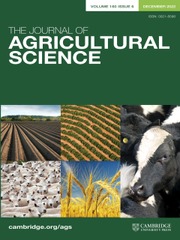Article contents
The impact of controlled breeding on milk production in pastoral goats in northern Kenya: an application of polynomial growth curve fitting
Published online by Cambridge University Press: 05 August 2003
Abstract
The paper investigates the effect of controlled seasonal breeding on milk production in a herd of Small East African (SEA) goats. Polynomial growth curve models were fitted to both daily and cumulative milk yield data obtained from an experiment conducted over a period of 4 years (1984–88) under simulated pastoral herd management in Isiolo District, northern Kenya. The experimental treatment consisted of six different mating seasons per year, which were replicated three times over the course of the experiment.
Milk yields in the first 2 weeks of lactation were negatively affected (<400 g/day) when kidding took place between June and September, whereas maximum initial yields of about 450 to 550 g/day were achieved at the onset and during the long rainy season. Multiple peaks in milk yield curves were observed when a rainy season occurred after about the first half of the lactation period. In terms of total amount of milk produced until 28 weeks of lactation, the production system could benefit from the introduction of a restricted breeding management allowing does to be bred in the period from June to November, with total milk yields being estimated at approximately 60 kg of milk. Maximum milk production until weaning can be expected to be achieved by does mated between October and January (between 46 and 48 kg of milk). The present experiment has revealed that mating just prior to or during the long rainy season leads to low milk yields until weaning and significantly increases the incidence of early kid deaths.
It is concluded that evaluating milk production in goat herds exposed to strong seasonal changes in forage supply is perhaps best carried out in terms of cumulative milk yields, instead of average daily yields, which are subject to large fluctuations. Furthermore, under these conditions fitting polynomial growth curves to longitudinal milk yield data using the general linear mixed model appears to be more appropriate than the estimation of non-linear algebraic lactation curves.
- Type
- Research Article
- Information
- Copyright
- © 2003 Cambridge University Press
- 1
- Cited by




